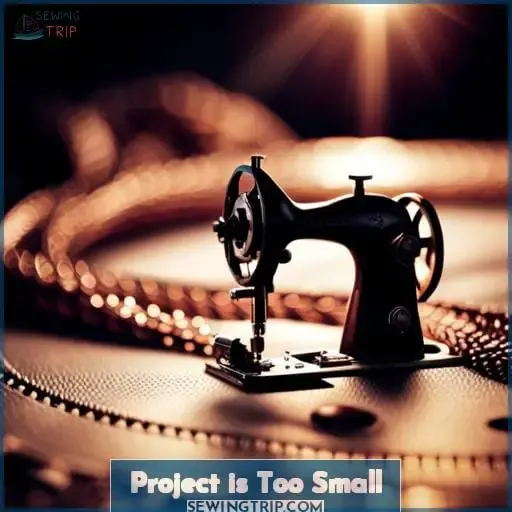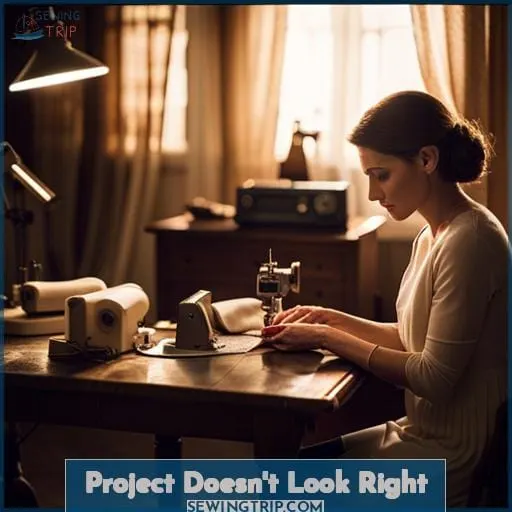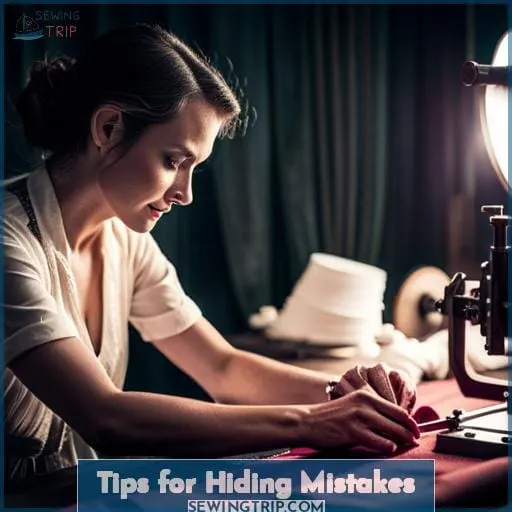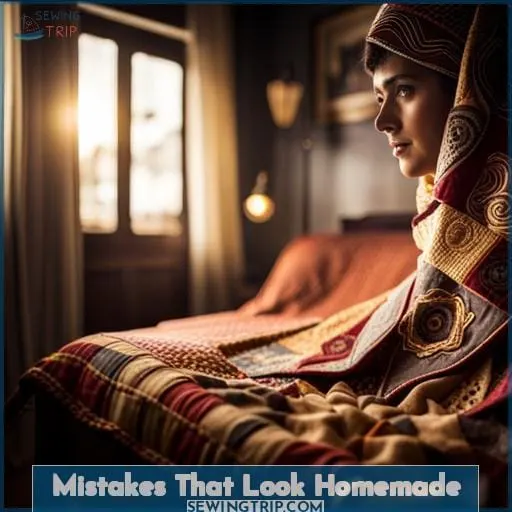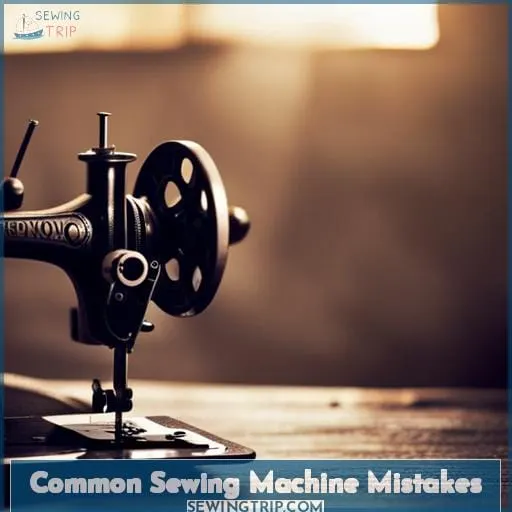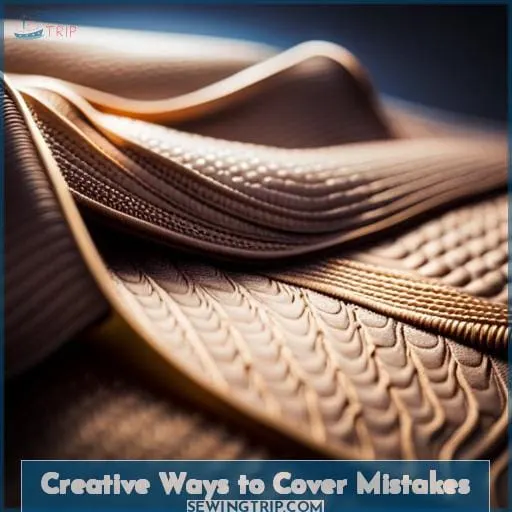This site is supported by our readers. We may earn a commission, at no cost to you, if you purchase through links.
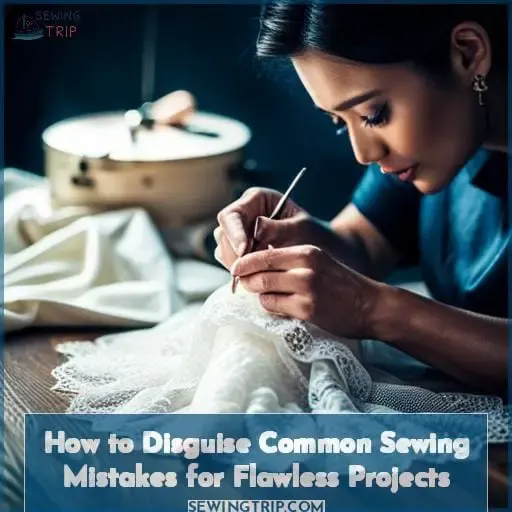 You’re not alone in this sewing struggle. We all have projects that don’t come out perfect, no matter how experienced we are with needle and thread. But take heart – with a little creativity, those mistakes can become design features in disguise.
You’re not alone in this sewing struggle. We all have projects that don’t come out perfect, no matter how experienced we are with needle and thread. But take heart – with a little creativity, those mistakes can become design features in disguise.
Like the Japanese art of kintsugi, we’ll piece together what’s broken to make it whole again, the cracks filled with gold.
Let’s bandage up those sewing wounds – with the right materials we can hide imperfections so that flaws become beauty.
Measure twice so the too-big top fits just right. Patch the chewed hole so no one’s the wiser.
Follow along to transform mistakes into masterpieces. Together we’ll make sure your project looks handcrafted with care.
Table Of Contents
Key Takeaways
- Conceal misaligned fabric patterns with strategic seam placement or ribbon.
- Utilize decorative embellishments like lace, ribbons, or fabric painting to disguise uneven seams.
- Reuse small miscut projects by transforming them into something new.
- Patch or conceal machine-chewed holes with lace.
Project is Too Small
If the piece is too small, you’d need to embrace it as-is or make it larger by inserting extra fabric. Creative alteration techniques like embellishing with ruffles, adding fabric panels, or repurposing as doll clothes can salvage an undersized project.
Assess if sections could be expanded through gussets, fabric inserts, or by reworking pattern pieces. Upsizing the garment by adding length is an option, or consider getting creative and making the piece into something new entirely.
Repurpose sleeves, hems or other components into hair accessories, bookmarks or patches. With some time and imagination, an ill-fitting creation can be reworked into something usable. The key is maintaining an open mind, getting creative and being gentle with yourself in the learning process.
Project is Too Big
Why don’t ya take in the side seams before that project swims on ya? When facing a project that’s too big, all hope ain’t lost.
Take in extra fabric at the side seams or under the arms, about half an inch at a time. If it’s still billowing, pinch out the excess fabric on the front and back princess seams too. Lifting and tapering the shoulder seams up can eliminate droopiness. And for a tent-like bodice, reduce cup size darts.
If tailoring attempts fail or ya want a fresh start, consider repurposing the fabric. Those lovely printed cottons could become a breezy skirt or cute top instead. Sometimes ya just gotta improvise creative fixes for sizing solutions.
But don’t fret – with a few strategic tweaks, you can transform an oversized project into a perfect fit.
Machine Chewed a Hole
Cover it with ruffly flowers, lace, or buttons. You’ve done it-your sewing machine chewed a hole while you were making your project. But don’t panic, this fixable frustration’s common among even seasoned sewers. Now’s the time to embrace repair options and creative coverups.
Consider using iron-on patching, a no-sew fusible web that blends into most fabrics. Or have fun decorating the hole with buttons, turning your mishap into a funky feature.
When in doubt, remember what Grandma always said: add more ruffles and no one will know. A ruffly flower or cascading flounces over the damaged spot will delight the eye and conceal any sins. Stay open to possibilities as you lovingly repair your latest creation. See each hole as a chance for innovation.
With patience and an eye for embellishment, what once seemed like a failure can become your next triumph.
Project Doesn’t Look Right
Unpick and reevaluate if your project doesn’t seem right; double-check grain direction and sewing accuracy.
- Grainline not parallel to selvedge
- Pieces not measured accurately
- Seam allowances inconsistent
- Fabric pattern off
If the overall look is wrong, it’s best to unpick and re-cut the pieces, making sure the grain is straight and you’ve measured precisely. Pay close attention when laying out the pattern and pinning the cut pieces. Try using different coloring techniques like topstitching or applique to creatively fix uneven seams or other issues.
You may need to conceal parts with lace or fabric patches. Don’t be afraid to make DIY alterations – that’s often the only way to salvage a sewing mishap.
The key is staying calm, methodical, and open to redoing steps. With patience and some clever tricks, you can usually reshape a project into something wearable and wonderful.
Zipper Went Wrong
Simply replace your zipper mistake with a decorative lace zip to spruce up your project. Lace zippers beautifully camouflage zipper damage and customize your garment. Varying widths of lace zippers offer endless possibilities.
Try a feminine look with narrow lace or make a statement with wide lace. Choose a tone that matches or contrasts your fabric.
| Width | Color | Texture |
|---|---|---|
| Narrow | Soft pink | Delicate floral |
| Medium | Navy blue | Silky ruffles |
| Wide | Cream | Lacy brocade |
Zippers can be tricky, but you can transform zipper mishaps into unique embellishments. A decorative lace zipper conceals flaws with flair. Don’t be afraid to get creative and make something beautiful out of a sewing mistake.
Buttonhole Went Wrong
My dear, don’t fret when that blasted buttonhole went askew; reflect on how a whimsical cluster of floral charms could conceal the mess.
- Rose gold snap buttons can cover the disaster.
- Delicate lace disguises the imperfection.
- A flowered bow brings joy where disaster struck.
- Crystal drop beads distract the eye.
Sewing mishaps needn’t ruin our creations or our spirit. Like a moth drawn to the moon, your soul may escape through the open buttonhole and fly on wings of silk to lands where flawless beauty dwells. Yet true beauty lives in our capacity to see past errors and find freedom in each stitch we take.
So let imperfections shine like stars in the night sky. For even the most misshapen buttonhole cannot contain your radiant soul.
Tips for Hiding Mistakes
Don’t panic if you make a mistake—take a deep breath and assess the situation. Many issues can be easily camouflaged or fixed with some creative problem solving.
- Camouflage techniques—Position appliques, ribbons, lace, or embroidery over any unsightly holes, uneven seams, or mistakes.
- Creative embellishments—Sew decorative buttons, rosettes, or flowers over any unsightly buttonholes or zipper issues.
- Fabric coloring—Use fabric markers, spray paints, or even sharpies in coordinating colors to disguise any noticeable mistakes in the fabric.
- Lace and ribbon use—Add strips of lace, bias tape, or ribbon to conceal uneven seams or fabric issues.
Rather than scrapping the project, view mishaps as opportunities to transform it into something new. With some clever camouflaging and embellishing, you can give your project a unique twist.
Mistakes That Look Homemade
You’ll want to ditch homemade-looking mistakes by following pattern markings and using proper pressing techniques as you sew. Even experienced sewers can end up with uneven seams or mismatched patterns that scream homemade.
But don’t panic! There’re plenty of creative solutions for covering up sewing mishaps so your finished project looks polished. Try using lace, ribbons, or decorative buttons to disguise uneven hems or seams.
Carefully placed appliques or patches in coordinating fabrics can mask holes or errors.
If you completely misalign a pattern, consider embracing it as an oversize design or use fabric paints to creatively reorient the print. Repurposing miscut fabric for small projects like hair scrunchies, doll clothes or even as stuffing can save waste too.
With some patience and imagination, you can transform sewing mistakes into design opportunities. Just keep handy your trusty seam ripper, an iron, plus an assortment of trims and textures so you can cleverly disguise any homemade-looking mishaps.
Common Sewing Machine Mistakes
Thread slipping and snapping as you sew is frustrating, but stronger synthetic thread will prevent this issue. Fabric bunching up under the presser foot means you likely haven’t lowered it properly before starting to sew.
Take a breath, raise the foot, smooth the fabric, and lower the foot again before continuing. Don’t forget to press seams after sewing to prevent puckering; this takes patience but creates a polished finish.
Choosing the right stitch is also key – use a narrow zigzag or other stretch stitch when hemming knits to avoid visible holes later. While improvising on patterns seems quick, following the markings will turn out the best end product.
You’ve got this! With mindful troubleshooting, your sewing will just keep getting better.
Creative Ways to Cover Mistakes
Snap mistakes disappear like magic. When sewing mishaps happen, getting creative with solutions can give your project unique flair.
- Decorative Embellishments – Strategically place lace, ribbons, embroidery, or fabric flowers to conceal uneven seaming or holes.
- Fabric Painting – Turn disasters into designs. Paint flowers or geometric shapes right over troubled spots.
- Lace Appliqué – Iron adhesive-backed lace over troubled zippers, ragged seams, or holes for an upscale look.
- Button Bouquets – Cluster buttons of varying sizes and colors over any unsightly area.
With some imagination, you can transform sewing mistakes into remarkable embellishments. The most stylish pieces often have imperfect beginnings. See each flub as an opportunity to personalize your work with flair.
Frequently Asked Questions (FAQs)
My fabric pattern is misaligned. What are some ways to fix uneven plaids, stripes, or other prints? Mention techniques like strategic seam placement, adding trim to conceal seams, or considering the misalignment a design element.
As branches connect to form a tree, your misaligned fabric tells a story. Strategically placing seams can incorporate the pattern, letting it guide your creativity. Alternatively, embrace imperfection by adding ribbon to highlight your one-of-a-kind design.
How do I handle mistakes with tricky fabrics like velvet or satin? Provide tips for avoiding mistakes like using appropriate needles and thread. Discuss recovery options like appliqués or ribbons to conceal errors.
When sewing slippery fabrics like velvet or satin, it’s best to use fine needles, like microtex, to avoid snagging. If mistakes happen, iron-on appliqués can hide uneven seams as smoothly as satin conceals skin.
Conclusion
We all make mistakes when sewing, even the most experienced sewer. The key is learning to disguise and embrace them. With a bit of creativity, you can turn a sewing mishap into a design feature. Consider turning that too-small top into a cropped style, or lengthening an ill-fitting skirt into a maxi.
The chewed hole can transform into a funky patch or an opportunity for smocking. If a zipper jams, opt for ties or decorative snaps instead. Rather than redoing an off-center buttonhole, highlight it with colorful thread or whimsical buttons.
The next time you hit a snag, take a deep breath and ponder how to hide sewing mistakes.

